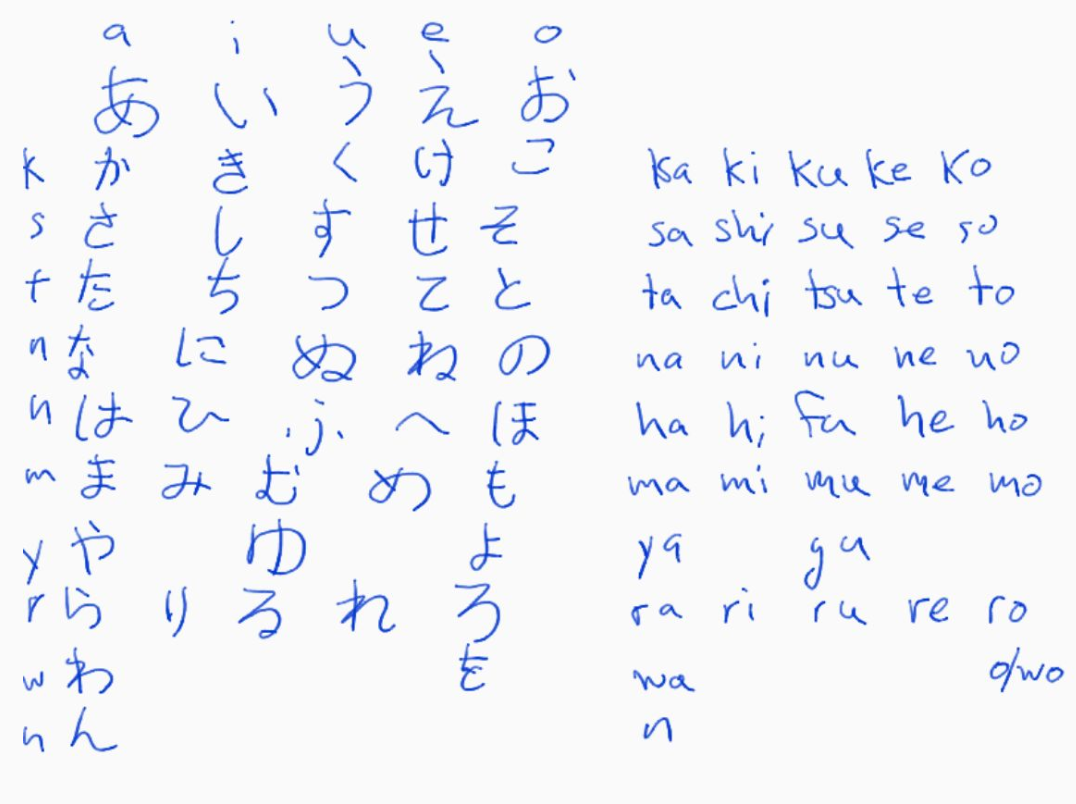001 Learning Japanese - Hiragana
This is a continuation of my arbitrary I think I'll learn Japanese post.
Note that because these are copied directly from my notes the diagrams will be atrocious, hand-drawn monstrosities.
Hiragana
I suspect it may be helpful while I'm learning Hiragana to recall the order of consonants in the chart. That way when I try to quiz myself at random, it will help me to deduce how many characters I'm forgetting.
The hiragana chart has vowels across the top and consonants down the side, then where these meet inside the chart are the various hiragana I'll need to remember.
So, across the top that's a i u e o (and they all sound like Spanish vowels that I kind of remember from high school) so that should make it a little easier.
Along the right side going down the consonants are k, s, t, n, h, m, y, r, w, n.
Some consonant vowel combinations don't seem to exist.
I might locate a hiragana chart to include here, they're all over the internet, but I'm going to produce one here by hand for practice. If I butcher any of the characters, please feel free to yell at me in the comments.
For anyone with the Genki text book, the Hiragana charts span pages 24 and 25.
Though the book uses "chi" for the sound of ち it would be written qi in pinyin. I need to note this or I will pronounce it like "chi" in pinyin and that's just wrong. Also, "shi" would be "xi".
For practice I'm going to spend the week just trying rote memorization of the chart. Every day I will practice two whole rows and then try to reproduce the hiragana chart up to the row that I'm working on. So, tomorrow I'm going to do the vowels and the k row. If I'm able to stick them in my brain such that I feel comfortable reproducing them, then I'll move to the next two rows.
My goal will be to over learn them so that I don't have to think very hard about writing them. I'm not just focusing on writing them, though. I'm going to be trying to write out vocabulary and sentences from the book. I'll use romaji when I can't remember a character and then I'll back fill the correct characters afterwards.
I'm, no doubt, going to have to come up with mnemonics, and I'll share those here, too, provided they're polite enough or interesting enough.
Hiragana with Diacritical Marks
Adding a pair of short strokes to k, s, t, and h become g, z, d, and b. The book calls them voiced, I assume they mean they have to kind of buzz with some volume when spoken.
I'm not recreating the chart with the diacritics, they all just feature the marks off to the upper right of the charaters, unless there is already a mark there, in which case the diacritics are to the left or slightly below.
The h sound characters become p sounds when a small circle is added. The circle is added to the upper right of the character. And I'm still not reproducing the chart because, seriously, the one above that I no doubt butchered took a long time to write out.
Note: I will be writing them out by hand, a lot, for practice. But I don't see an advantage to doing it on the tablet right now.
Contracted Sounds
I don't see the significance of the table on page 26, so I'm not going to reproduce it here, either. It just looks like putting ki, shi, chi, ni, hi, mi, ri next to ya, yu, and yo. I don't see where anything is written any differently, except maybe the second character is a little smaller.
Double Consenants
The character su つ is repeated next to a character to indicate that the next consonent is to be repeated, but when repeating the n sound an ん is put in instead.
Feedback
I'm making these notes as I read the text book. If you spot any mistakes, please leave a comment. Even if the seven day window for editing has closed.
References:
- Genki: An Integrated Course in Elementary Japanese I, Second Edition, 2011.
Previous Post(s) in the Series:
